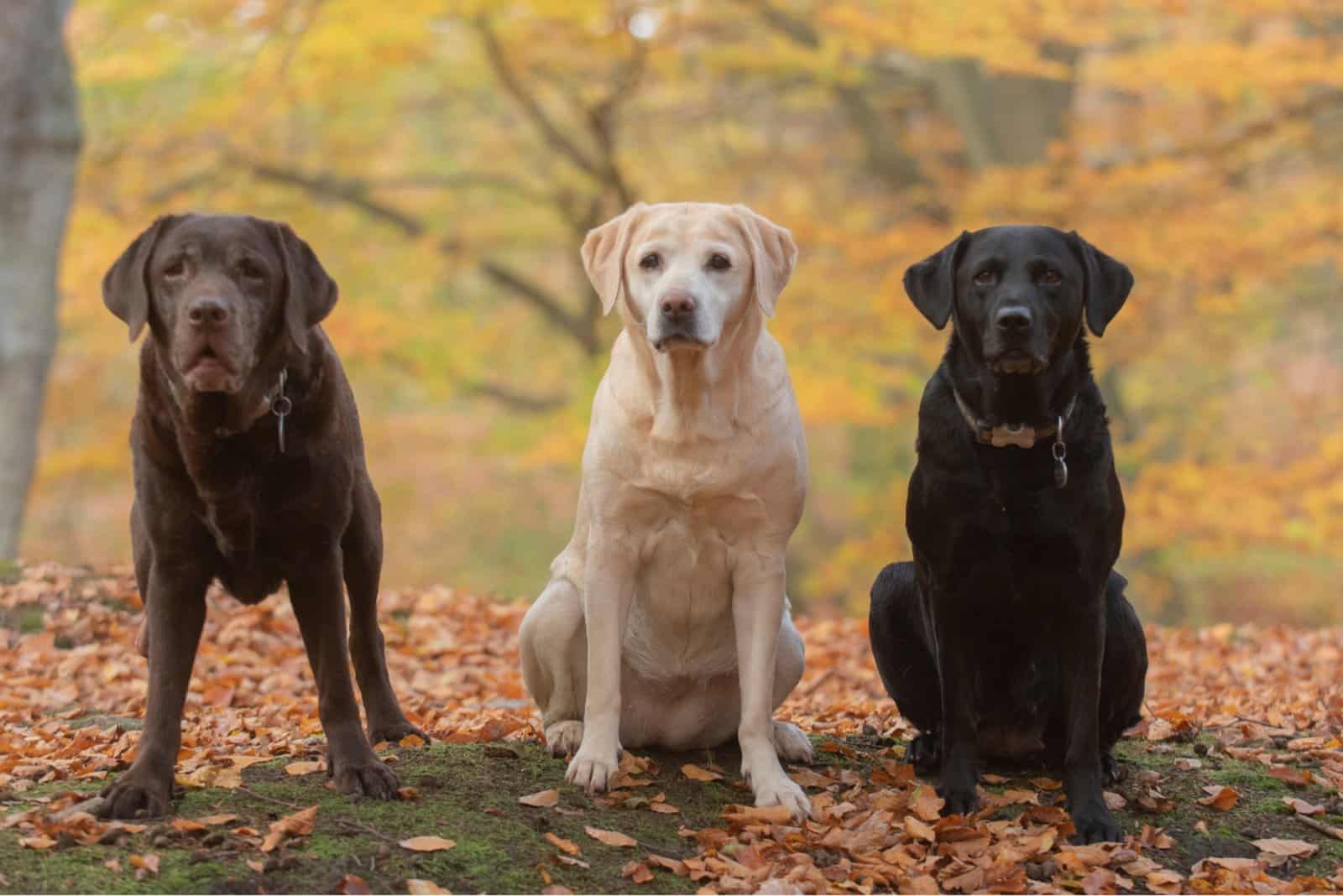Labrador Retrievers are known as the most popular dog breed. Primarily bred as hunting and working dogs, they inherited some of the best traits among all purebred dogs.
Their coat is double-layered, made for different weather conditions. Not only is it durable in hot and cold conditions, but it is also a great protective barrier.
Thick, water-resistant, and shiny…their coat is also perfect for swimming!
Coat colors of Labradors depend on the genotype of both parents. Specialized breeders carefully select different colored Labs to produce desirable colored puppies.
So, there’s a lot of science going on about color theory in Labradors. Nevertheless, selective breeding has resulted in some amazing color combinations of the Labrador Retriever.
Let’s get right into the vivid world of Labrador colors!
Three Main Labrador Colors

There are three main Labrador colors that you have already heard of – black, yellow, and chocolate.
These three different colors are officially recognized and described by the AKC (American Kennel Club).
Other colors and markings we’ll be talking about in this article fall under these three main categories.
Let’s find out more about black, yellow, and chocolate Labrador Retrievers!
1. Black Labrador.

Black is the most common color among the Labrador dog breed.
Their coat comes in solid black without any other markings and patterns. This is likely due to the black color being the dominant gene variant.
Okay, so we know Labradors are hunting dogs that were bred for assisting hunters and retrieving game.
But, did you know that black Labrador Retrievers have been the most sought-after among all other Lab colors?
Reasons why people choose black Labradors
There are some reasons behind this.
Firstly, their dark, black coat helps them blend in with shadows of the forest or any other hunting ground. They are basically in stealth mode!
The second reason is a bit controversial. Most hunters say black Labs are more trainable than any other color. But, is this really true?
Well, not quite. It’s important to know that every dog has an intelligence and a personality of its own.
Since black Labs are more common, this might be the reason why most will say they’re smarter than the rest – there’s simply more of them.
All black puppies will be born with blue eyes that will later turn dark brown. It’s extremely rare to see an adult black dog with blue eyes. The nose is usually the same color as the coat.
Black Labs are just as trainable as any other Labrador breed. Originally being bred as gundogs, they’re highly motivated and eager to learn.
Another pro when it comes to their black coat is they’re fairly easy to maintain. In comparison to lighter coat colors, a black coat is visually shinier and thicker.
2. Yellow Labrador.

Yellow Labradors are not really yellow. They’re mostly blonde with different shades of yellow.
This is the second most common color of the Labrador Retriever.
You can often see these wonderful dogs on TV commercials, dog shows, and in magazines. Yellow Labrador Retrievers are real superstars of the canine world!
A yellow Labrador looks as if a Golden Retriever went for a haircut!
These cute blondies have become very popular family dogs. In fact, they stand at the very top of The American Kennel Club’s list of best family dogs.
Because they’re so smart, yellow Labradors effortlessly pass every job interview, and they usually get hired as service dogs.
Their coat comes with light, almost white tones, and some come with shades of orange. It all depends on breed genetics as well as your dog’s age.
Most of these shades can be seen on the ears, the snout, the tail, and the surface of their back. These areas are usually darker in color than the rest of the body.
Having short, thick, double-layered coats, these dogs are made to endure any weather condition. But, they do shed a lot.
Their little noses are often brown or solid black. Yellow puppies are all born with blue eyes. As they mature, their eye color ranges from light to dark brown.
Although rare, some yellow Labs may inherit the recessive gene linked to blue eyes and a light brown nose.
Once they look at you with their cute puppy eyes, you’ll immediately fall in love!
Here’s a fun fact
Did you know that yellow Labs get darker as they age?
Well, even though it may sound strange, the yellow coat doesn’t get any darker as years go by. Your senior Labrador will likely develop a lighter coat than that when he was a puppy.
People turn gray as they age; yellow Labradors turn white to light yellow.
Besides age, proper nutrition plays a huge role in your Lab’s coat color.
Now, we don’t mean that certain foods will make their coat darker or lighter. Good nutrition will enhance the quality of their coat, making them shinier and thicker.
On the other hand, poor nutrition will make their coat drier and thinner. By drying and thinning out, the hairs will become lighter; thus, making the coat a lighter color.
White, Fox Red, and Dudley Labradors fall under the main yellow category. We’ll get to them soon, so stay tuned!
3. Chocolate Labrador.
Although brown, people like to call them chocolate Labradors. Well, chocolate is brown, so you get the point.
Surely, people call them chocolate because they’re so sweet!
Even though it may seem that black and yellow Labs took most of the fame, the chocolates are becoming more and more popular.
Chocolate used to be the rarest color of the main three Labrador colors.
Breeders had a tough time developing this color. Both yellow and black colors were dominant towards the brown shades. This means that the chocolate color is a recessive gene.
This might also be the reason why chocolate Labradors are higher in demand and more expensive.
Luckily, by using genetic testing, specialized breeders are able to develop healthy and beautiful chocolate puppies.
So, we get to see more of them each day!
Actually, we can see many chocolate Labs in show rings. Being such good and loveable show dogs, they attract lots of attention!
While doing your research, you’ll often stumble upon the question of whether chocolate Labradors are more difficult to train than other colors of this dog breed.
See Also: 11 Amazing Chocolate Lab Breeders From All Over The USA!
Are chocolate Labradors really that stubborn and hard to train?
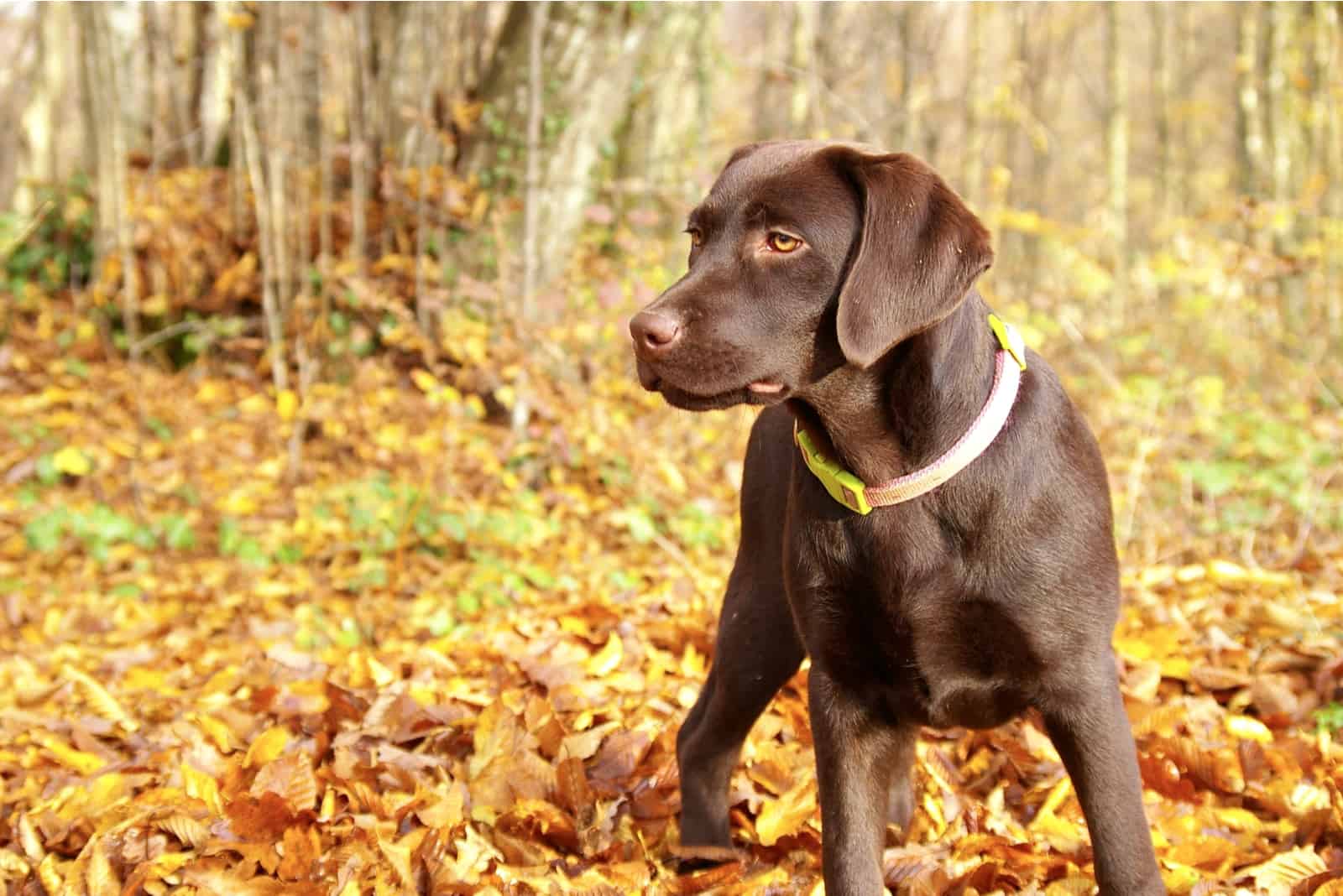
There’s no exact evidence that could potentially prove that. Each dog can be difficult to train if you don’t put time and effort in the training process.
The color of the coat doesn’t necessarily mean that your dog will be smart or dumb, stubborn or obedient.
Chocolate Labradors make amazing family dogs: they’re fun-loving, adventurous, calm, and loyal to their owner.
Not only that, but these Labs are very unique-looking. Their shiny coat varies from light to dark chocolate colors.
Following the coat color, the nose is usually brown. This can change with age – older dogs have lighter shades of brown noses.
Their eye colors usually vary from hazel to brown… some may inherit amber eyes, which is really rare. Blue eyes are usually seen in newborn pups as this is the case with all baby animals.
No wonder there’s a huge interest for chocolate Labs… they are simply gorgeous!
Keeping up with their looks requires lots of patience with grooming and shedding. They need to be brushed regularly.
Chocolate Labs love swimming, so don’t be surprised if your water dog goes out to the beach or a lake for a good swim!
Three Common Labrador Colors
The next three colors became quite common in the past years. In fact, they’re so common that people put them together with the main colors.
However, red, white, and silver Labrador colors aren’t officially recognized by the American Kennel Club.
1. Red Labrador.
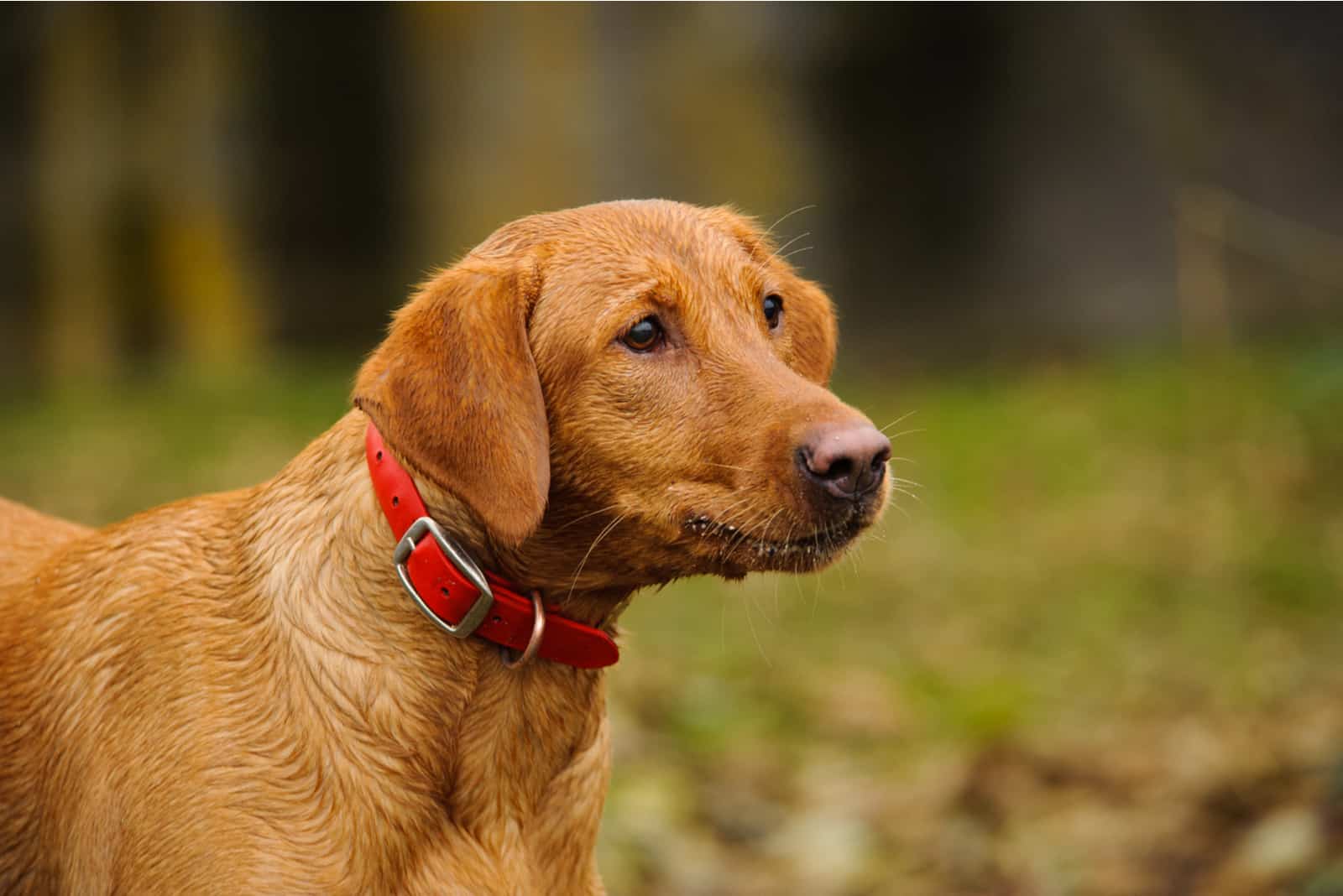
Red Labradors are pretty rare. Their coat color derives from the main yellow Labrador.
These dogs are also known as Fox Red Labradors because their coat colors resemble the ones we see in red foxes.
What makes this dog so special?
Here’s some science behind the Fox Red Lab.
Let’s start off by saying their color genes are recessive.
Genes make up chromosomes. There are two versions of each gene within a chromosome. All genes, including color genes, have two different variants that are called alleles.
So, alleles basically “control” particular traits (black hair, blue eyes, a brown nose), and they can be either dominant or recessive.
The dominant allele is the one that’s expressed more strongly, so it completely masks the recessive allele.
Puppies inherit two alleles for each gene – one from their mother and one from their father.
If these alleles are the same, the puppies will be homozygous. This means they inherited two copies of the same dominant allele.
If an allele from one parent is different from another, we’ll get heterozygous puppies. This means they inherited two different alleles. One of them is dominant, so it will mask the recessive one.
So, how did this Labrador turn red?
Coat colors in dogs are produced from two pigments: eumelanin (black), and pheomelanin (red).
Scientists have discovered a gene that can turn off the eumelanin pigment. This gene is called the “e gene”.
Yellow Labradors produce only pheomelanin, so if puppies inherit the “e” gene from both parents, their coat will be in the yellow spectrum.
Later on, alleles will control the pheomelanin pigment leading to the formation of red color. This will give the Fox Red Lab its signature look.
There is a lot going on when it comes to the breeding process and genetics. It’s a very complex subject that breeders thoroughly study in order to create healthy and good-looking dogs.
Red Labradors are exactly that – beautiful dogs in the center of attention!
2. White Labrador.
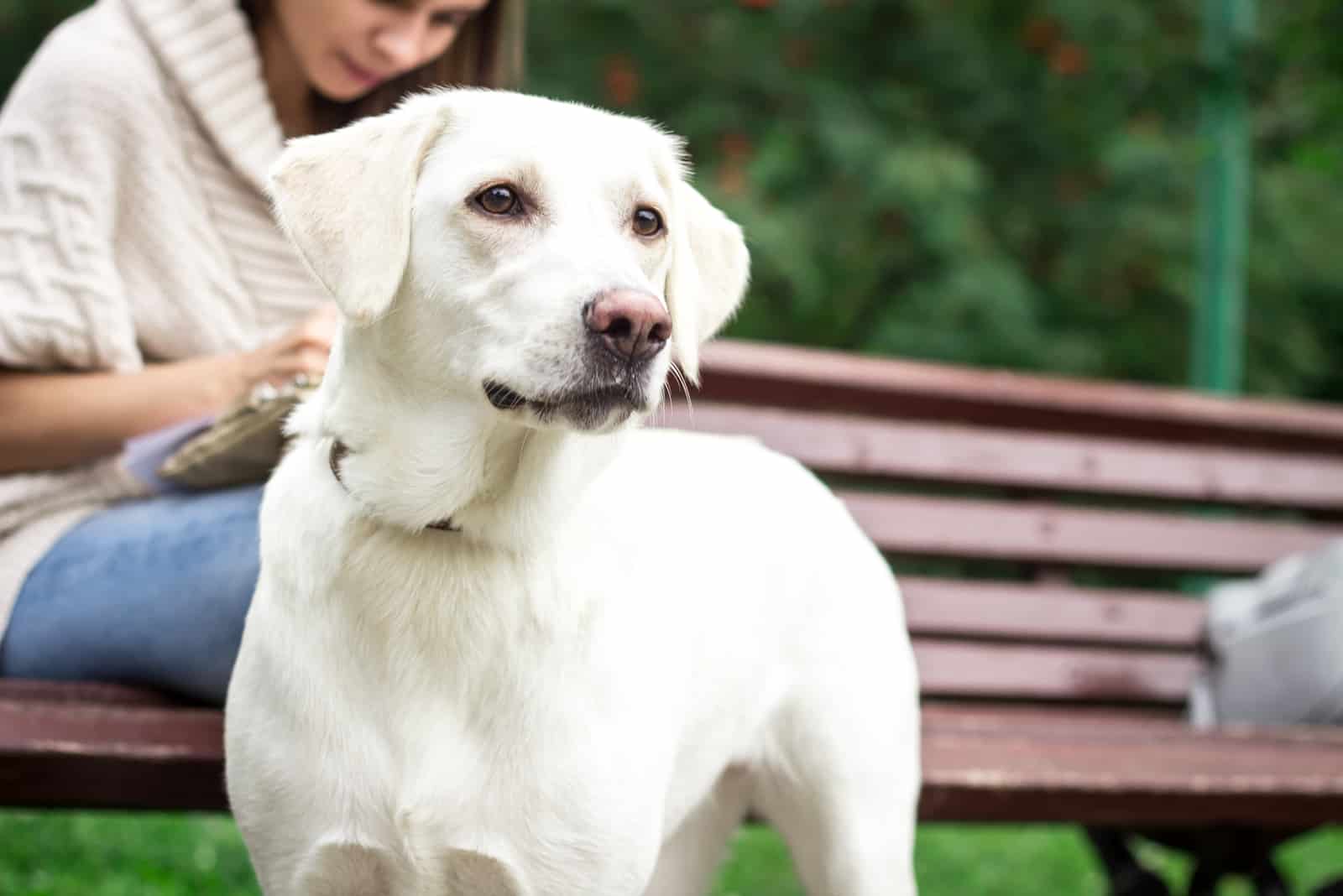
White Labrador Retrievers also belong to the yellow color spectrum. They’re actually yellow Labradors that turned out to be paler due to specific breeding.
For this color, specialized breeders definitely knew what they were doing. It takes lots of experience and knowledge to intertwine the genes from both parents in order to produce this beautiful dog.
White Labs are known for their pale coat color. You can usually see lighter shades of yellow on their ears, their snout, the surface of their tail, and on their back.
White Labradors are not albino
A common misconception is that white fur = albino. Well, while it is partially correct, it’s still not entirely like that.
Albino dogs certainly do have white coats. But, they also have pale, pinkish skin. Their nose and paw pads are also pink.
Their eyes are usually very pale, which makes a huge difference when comparing albino Labs to white Labs.
White Labradors always have dark eyes, a black nose, and black paw pads.
Like all Labrador Retrievers, white Labs also have a double-layered coat that serves to both cool them down during hot summer days, and warm them up during winter.
They tend to shed a lot, so it’s important to make a daily grooming routine.
3. Silver Labrador.
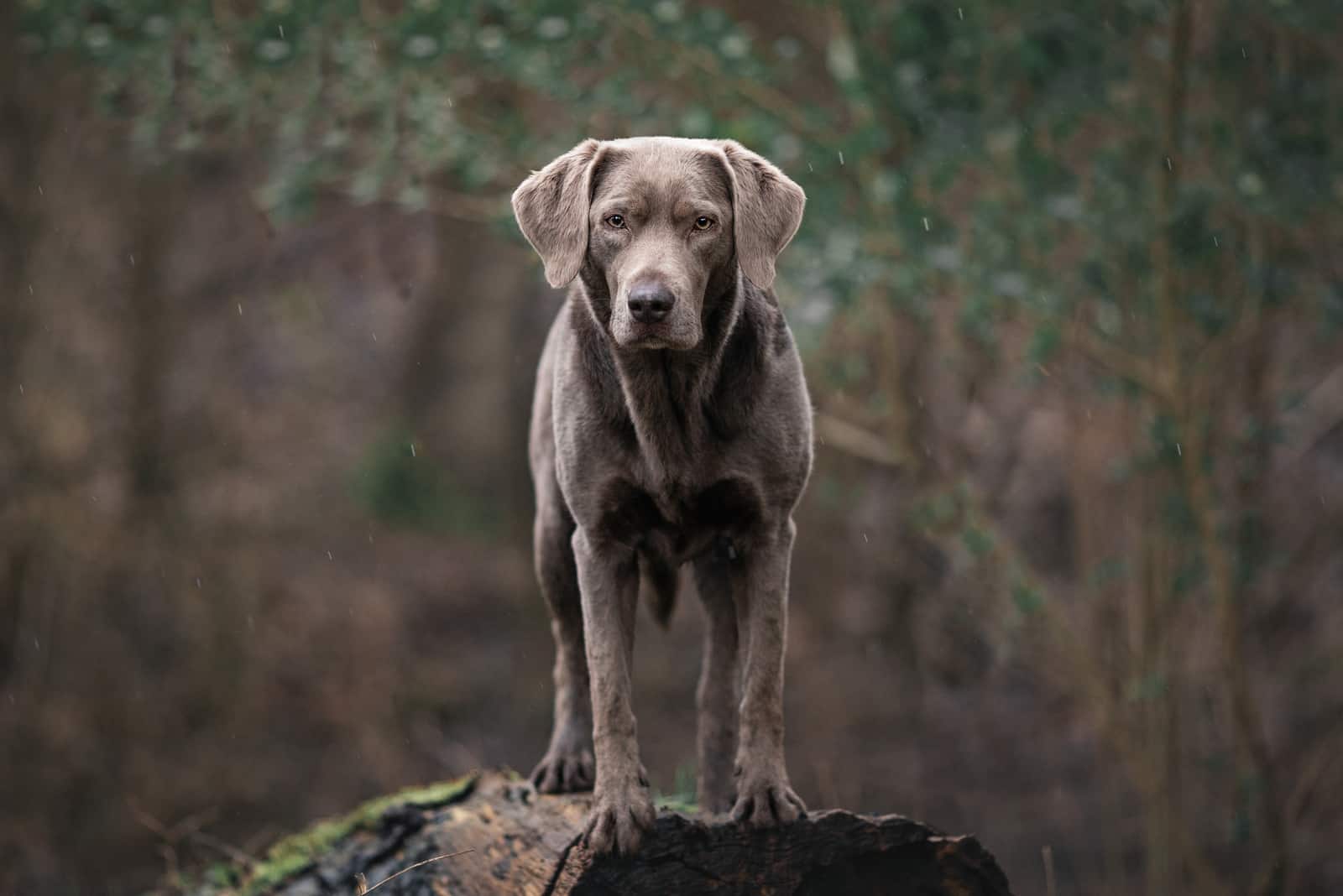
Sometimes mistaken for a Weimaraner, a silver Labrador is a rare sight to see. Unlike the Weimaraner always being gray, the Labrador Retriever develops this shade very rarely.
Silver Labradors are new to the club. Breeders are not entirely sure how they have come up with this rare color.
Scientists have discovered two recessive genes that are to blame for the distinct silver coat.
The story about the dilute gene
The dilute gene is a color gene in dogs that is responsible for coloring the hair in light to pale shades. We can clearly see that this silver isn’t as vibrant as other colors.
There are some theories claiming that a silver Labrador isn’t considered a purebred dog. In fact, silvers are not recognized by the Kennel Club.
Silver Labrador Retrievers are considered to be under the chocolate main color category. The American Kennel Club registers silver Labs as chocolate Labs.
This Labrador coat is considered to be the most unique among this breed.
With an extremely shiny gray to silver coat, these dogs have a very elegant and noble appearance.
Even though they are registered as chocolate Labs, silver Labs aren’t considered show dogs. But, they can participate and be seen in show rings.
Silver Labradors are truly remarkable, loveable dogs that will make a great addition to the family.
Their coat requires daily grooming and care, so they can be extra shiny and healthy!
Six Rare Labrador Colors And Markings
Now it’s time to show you some of the rarest Labrador colors and markings. These combinations are so rare that most of us have never even heard of or seen them.
Well, now’s the perfect chance to get to know a thing or two about the rarest Labrador Retriever color combinations.
1. Merle Labrador.
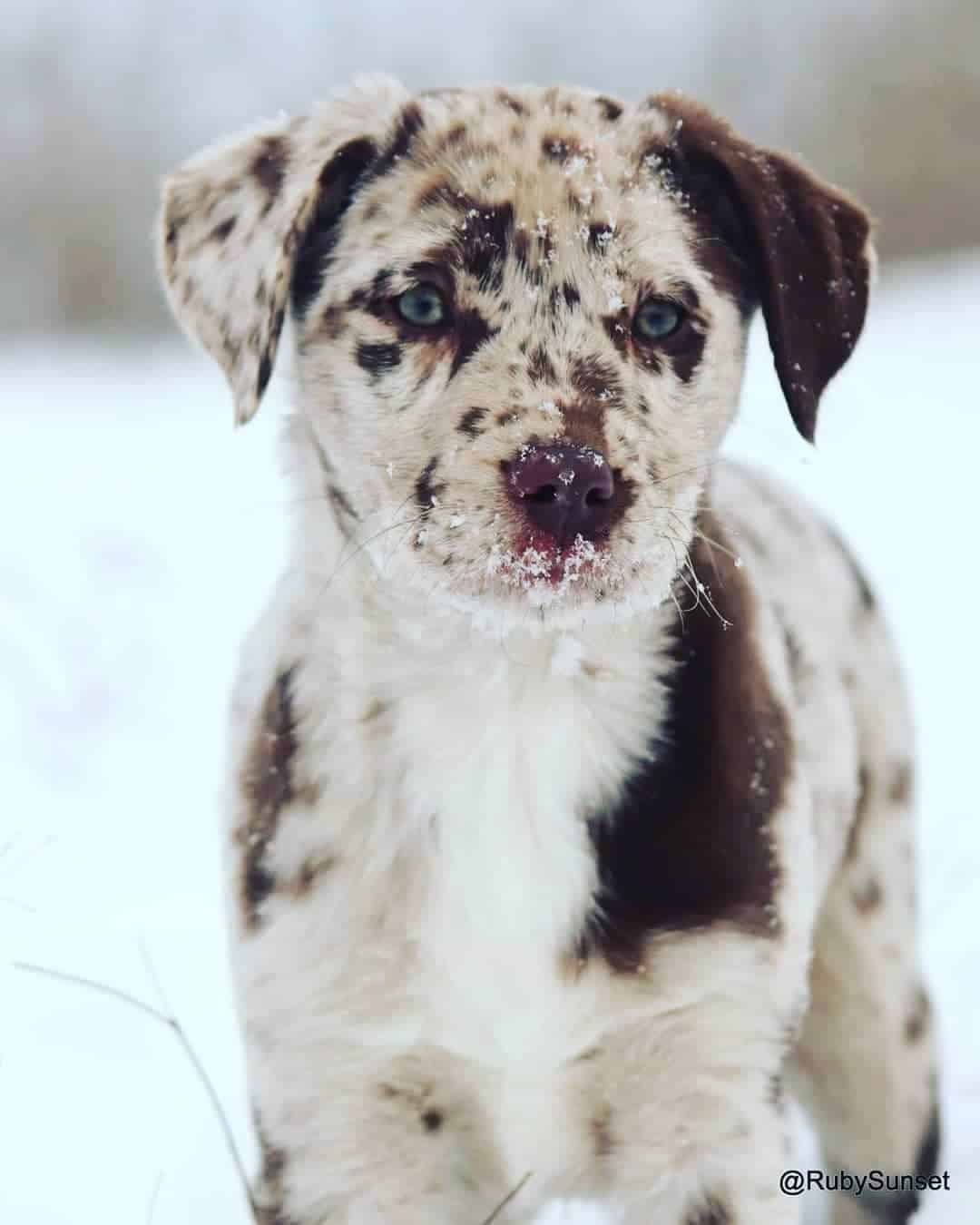
Photo from: @leos_labs.of.ruby_sunset
Yes, merle Labradors do exist!
Their coat is very specific, and designed in uneven, irregular patches of diluted pigment and solid color.
This is a very rare combination of recessive genes. Merle Labradors aren’t seen very often – neither in litters, nor in public.
It’s all about genetics!
In genetics, recessive genes are written with all lowercase letters. For example, the eebb genotype carries two recessive chocolate color genes.
When breeders succeed in developing a merle Lab pup, it is considered as a really huge surprise. Imagine the excitement of seeing a merle pup!
Merle Labs can be a combination of black and white spots, as well as light to dark brown spots. Diluted and solid, both color variants are included in this rare combination.
Their nose and paw pads can also be in different colors. It’s quite interesting to see a colorful snoot!
Some merle Labrador puppies develop heterochromia – a state in which two eyes are of a different color! Now, there probably aren’t many merle dogs that inherited this rare trait.
2. Brindle Labrador.
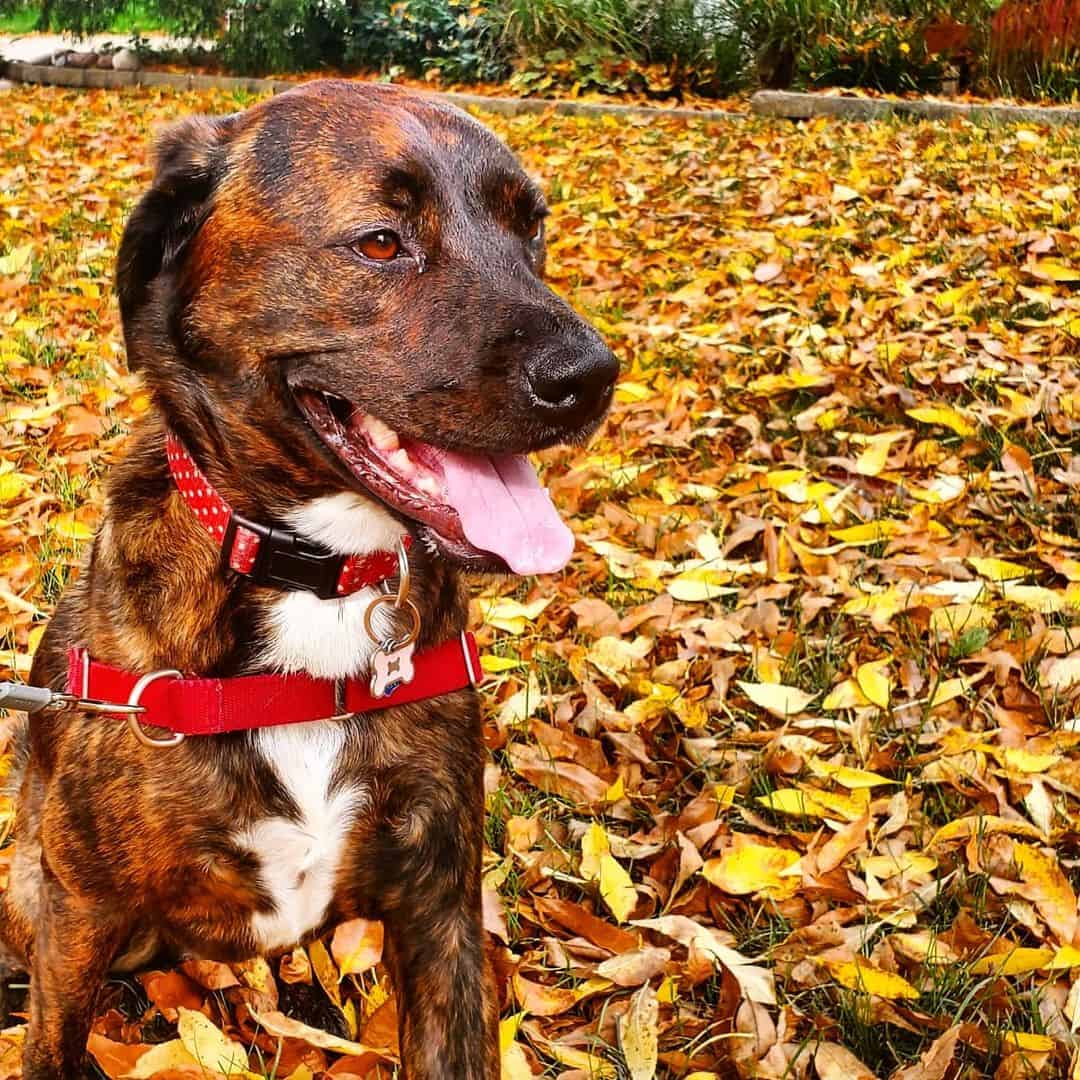
Photo from: @panela180
Although brindle color is common in other dog breeds, brindle Labradors are an uncommon sight.
This unique pattern is a combination of various colors: brown, black, light brown, orange, and sometimes white.
Most brindle Labs will inherit white spots around their paws and/or a long white spot along their chest and belly.
Small tiger? No, it’s the brindle Labrador!
Brindle patterns are often described as tiger stripes. This makes brindle Labs look like mini tigers! Well, almost.
With striking hazel-colored eyes and a tiger-striped coat, these dogs are impossible to miss.
A brindle coat is usually seen in dogs with a short-length coat. Our Labrador Retrievers have a short to a medium-long coat.
Whether they’re going to be born brindle depends entirely on genetics. Specifically, it depends on the K gene that’s responsible for coloring the puppies’ brindle.
Brindle Labradors usually have a dark brown nose. A lighter nose color is very rare.
Even though these are purebred dogs, because of this pattern, they’re usually not allowed to participate and be judged in the show ring.
The brindle color is considered as a breeding mistake. So, only those Labradors that come in the three main colors may participate as competitive show dogs.
3. Dudley Labrador.
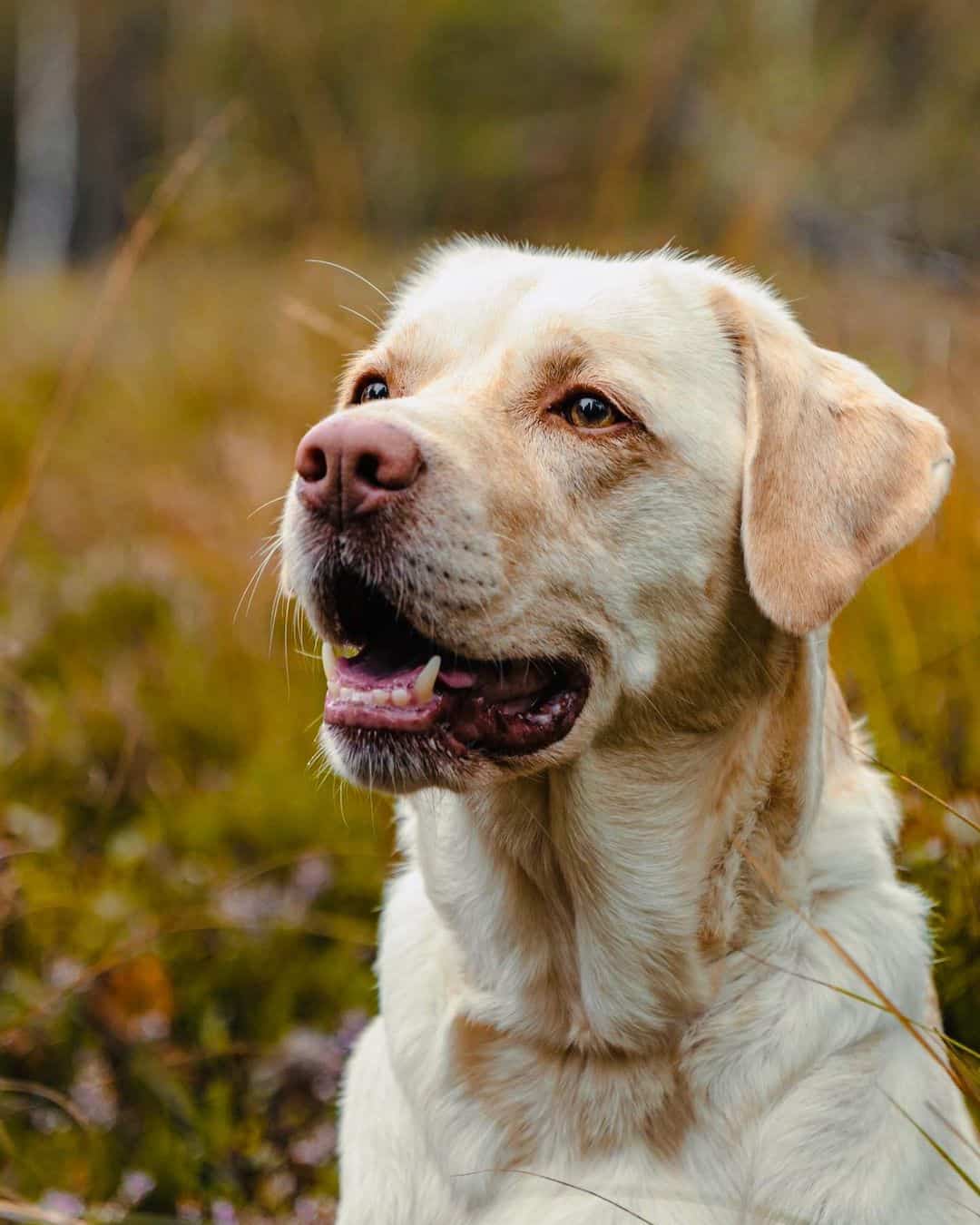
Photo from: @labbi_glueckauf8pfoten
You might have heard of this rare Labrador. The dudley Lab derives from the yellow Labrador Retriever. Although considered rare, they can be seen more frequently in recent years.
They usually come in lighter shades of yellow, with darker color tones around the snout and the ears.
What makes the dudley Labrador so special?
His little nose! Yes, his nose is the main feature we use to distinguish whether it’s a yellow or a dudley Labrador.
Dudleys are known as pink-nosed Labradors. Their nose is pale, usually ranging from very light brown to soft, baby pink.
Dudley puppies are born with a pink nose that seems to get darker as they age. Their nose can never become completely dark, like solid black or brown.
Following this pigment, the paw pads are colored in mentioned light shades.
Their eyes come in different colors, ranging from different shades of yellow to light brown and hazel.
Other than a pinkish nose and paw pads, and light eyes, their eye rims also come in lighter shades of pink and beige.
Just like other rare colors, the dudley isn’t considered a good contestant for show rings. While it surely seems unfair, the kennel clubs have rules to follow when judging and rating purebred dogs.
Dudley Labs are still purebred Labrador Retrievers. So are the other mentioned Labs in this article.
Different colors, patterns, and markings of the Labrador don’t have any impact on this breed’s personality traits.
4. Black and Tan Labrador.

Photo from: @lunatheblackandtanlabrador
When you look at the black and tan Labrador, the first breed that might come to your mind is the Rottweiler.
Well, although they might look similar in terms of coloring, these two dogs haven’t been crossed in order to achieve the black and tan Labrador.
This Labrador is a purebred dog, just like any other purebred Labrador Retriever.
Tan makes the best accessory!
They’re very cute and unique puppies that are often unexpected in litters. Most breeders are surprised when they see these colorings on their new puppy.
Compared to other colors of Labradors, black and tan Labs aren’t very high in demand. But, it is safe to say that they became quite popular among paw lovers.
Black and tan Labradors can derive either from the chocolate Lab or the black Lab. It’s all about mixing and matching those color genes!
Tan markings are often seen as little circles above the eyes as if they got their eyebrows dyed!
These markings are also seen on their cheeks, legs, and along their chest. The chest markings are more horizontal than vertical, and are wide with irregular edges.
Black and tan Labs have different colors on their paws. Some may have all four paws in the same tan shade, while others can have a single tan paw. Guess some Labs forget to wear their tan socks!
The nose and eyes are usually very dark in color. Some exceptions include a brown nose and light-colored eyes, but these combinations are very rare. Ears are almost always black, like the rest of the body.
When it comes to show rings, the same goes with this kind of Labrador Retriever – they will mostly be disqualified because these colors and markings aren’t considered preferable.
5. Chocolate and Tan Labrador.
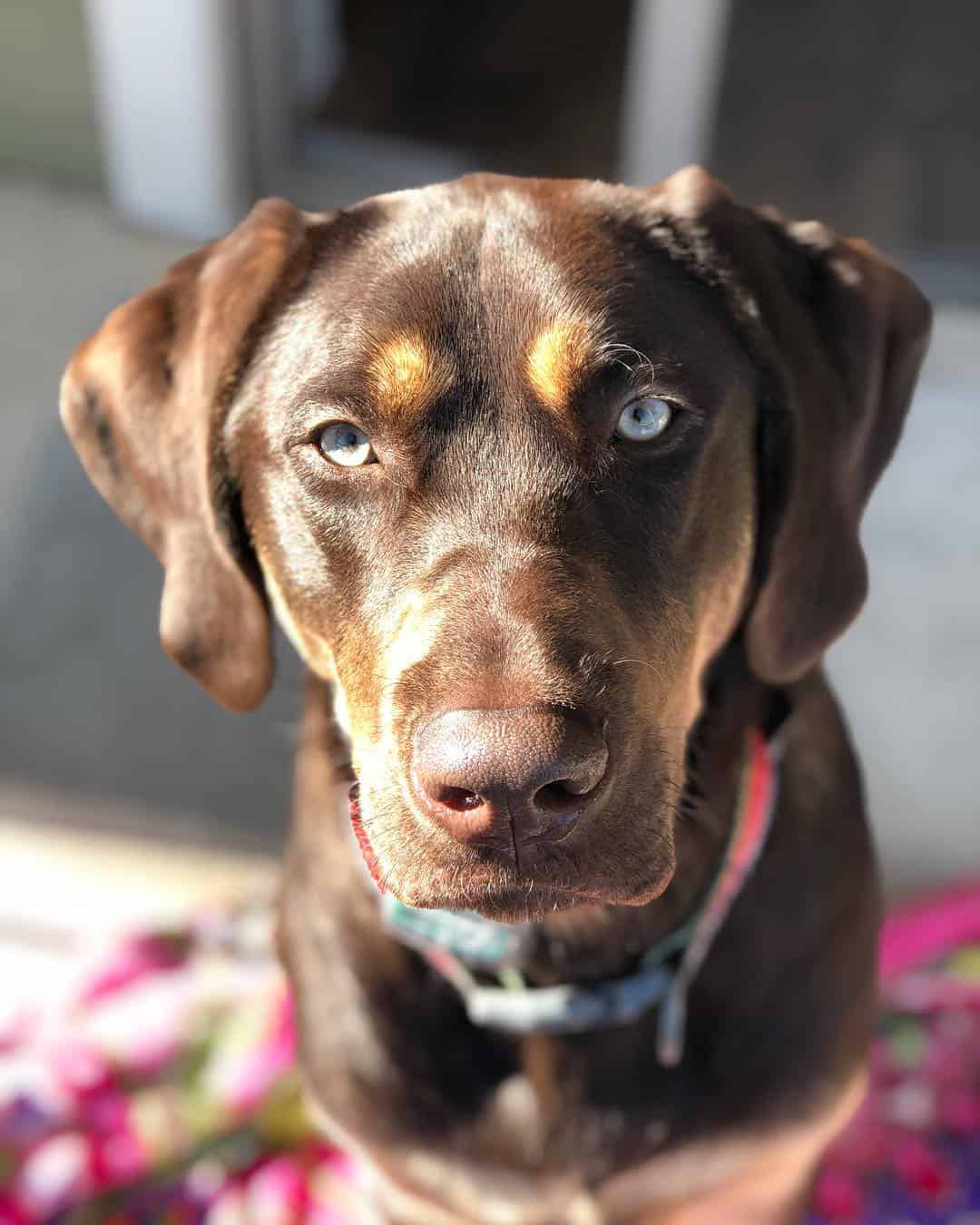
Photo from: @kelsotheagoutilab
We learned that chocolate is the rarest of the main three Labrador colors. Therefore, chocolate and tan is the rarest color of the Labrador Retriever dog breed.
The color of chocolate goes beautifully with light tanned tones that cover different parts of the body.
Similar to the black and tan Labrador, tan markings are usually seen on the eyebrows, around the nose, and along the legs and the chest. Tan coloring can also be present on the tail.
Eyes are often dark, sometimes with lighter combinations that develop a honey-hazel color. As for the nose, it can be either brown or black.
Chocolate and tan Labradors look like big plush teddy bears!
Their coat is double-layered, soft, and appears shiny. Of course, all of this is achieved by a proper grooming routine and good nutrition.
Although a different coat color doesn’t mean a different behavior, scientists have discovered something else that’s linked to the coat color.
Different colors, different health problems?
They found out that chocolate, as well as chocolate and tan Labradors, are more prone to certain health issues than other Labradors.
These health problems include different skin conditions and ear inflammations.
How did this happen?
Well, to answer this question, we’ll have to get back to the gene story.
Throughout their research, scientists have discovered a link between color genes and health status. It is believed that dominant genes (black and yellow) play a role in strengthening the immune system by reducing and/or preventing inflammation.
On the other side, recessive genes (chocolate) aren’t as protective and strong in reducing infection. So, it is believed that the selective breeding of the chocolate Labs made them less immune to certain health problems.
Since chocolate and tan Labs fall under the chocolate Labrador color category, the same goes for these dogs.
Naturally, lifespan is connected to health status. Therefore, it is said that chocolate Labs have a shorter lifespan compared to other Labradors. They usually live from nine to 10 years, almost twice as short as average Labrador Retrievers.
6. Labrador with White Markings.
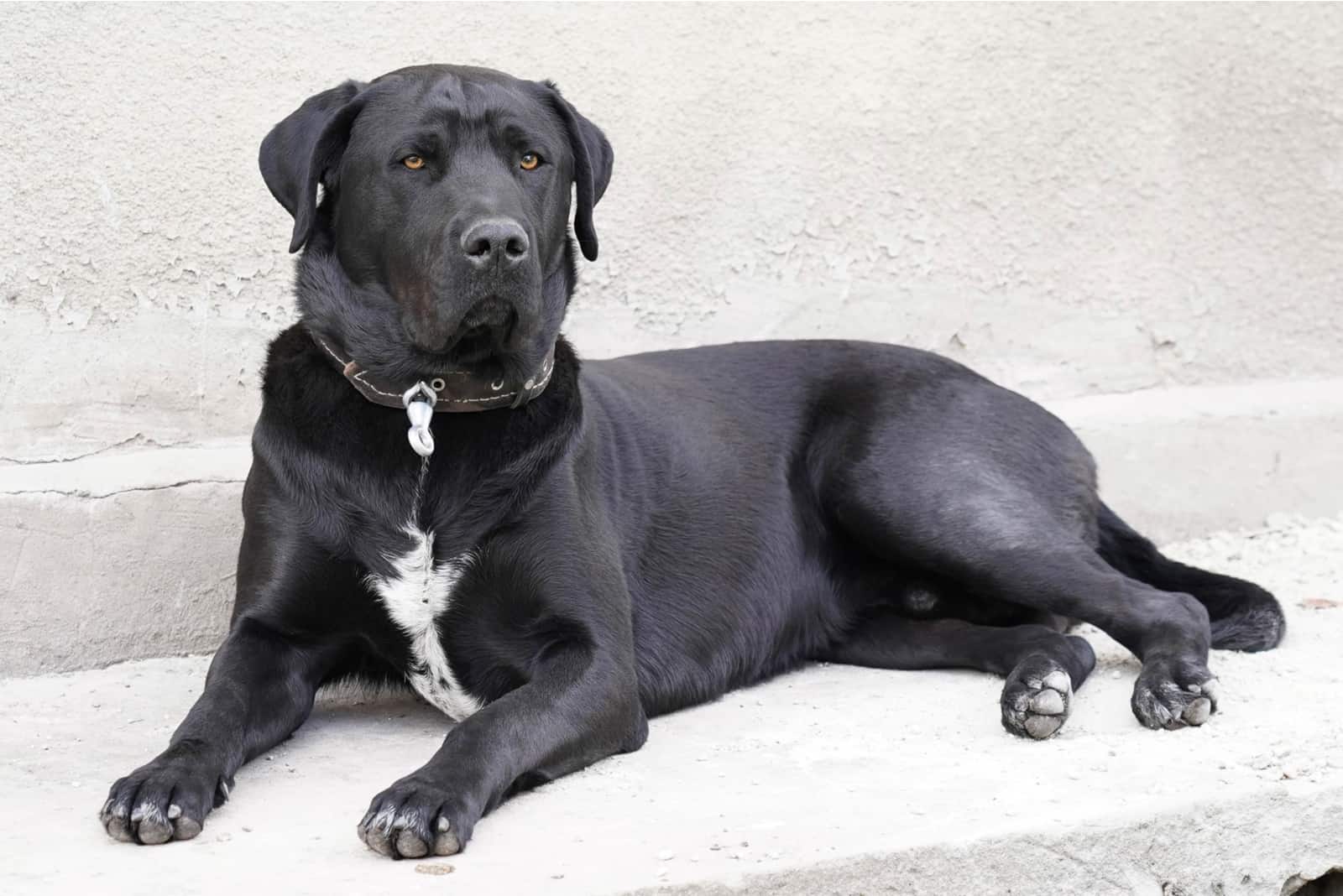
What do you call a Labrador wearing a tuxedo and white socks? A Labrador with white markings, of course!
Labradors with white markings are black labs with white spots. But, we’re not talking white spots as in reversed black Dalmatian spots.
White markings are trendy
These markings are larger and wider patches of white color usually found on this Labrador’s chest, tail, and paws. Specifically, white color can be found along the tail or at the tip of it.
When it comes to their feet, some can have two or all four feet colored in white, whereas some can have all four white feet. There are many combinations, each different from another.
Looking at this Lab, he kind of resembles a Cane Corso in terms of coloring. They almost have the same white patches.
Actually, Labradors are thought to be genetically linked to the extinct St. John’s water dog that had the exact same markings.
Black Labradors with white markings usually don’t have any white color on their head, nose, and ears. These parts are always solid back.
You might notice white hairs on black Labradors. These hairs can be found on their muzzle and their eyebrows. But, this is due to aging. Senior dogs will often have some white hairs!
Black puppies are born with distinct white markings that do not alter as they age. Although this is considered rare, many breeders often get this color in their litter, especially when combining black and yellow Labs.
Unfortunately, although these dogs are purebred, they can’t participate in show rings as show dogs.
The official breed standard demands purebred Labrador Retrievers in three main coat colors.
What Are Bolo Marks?
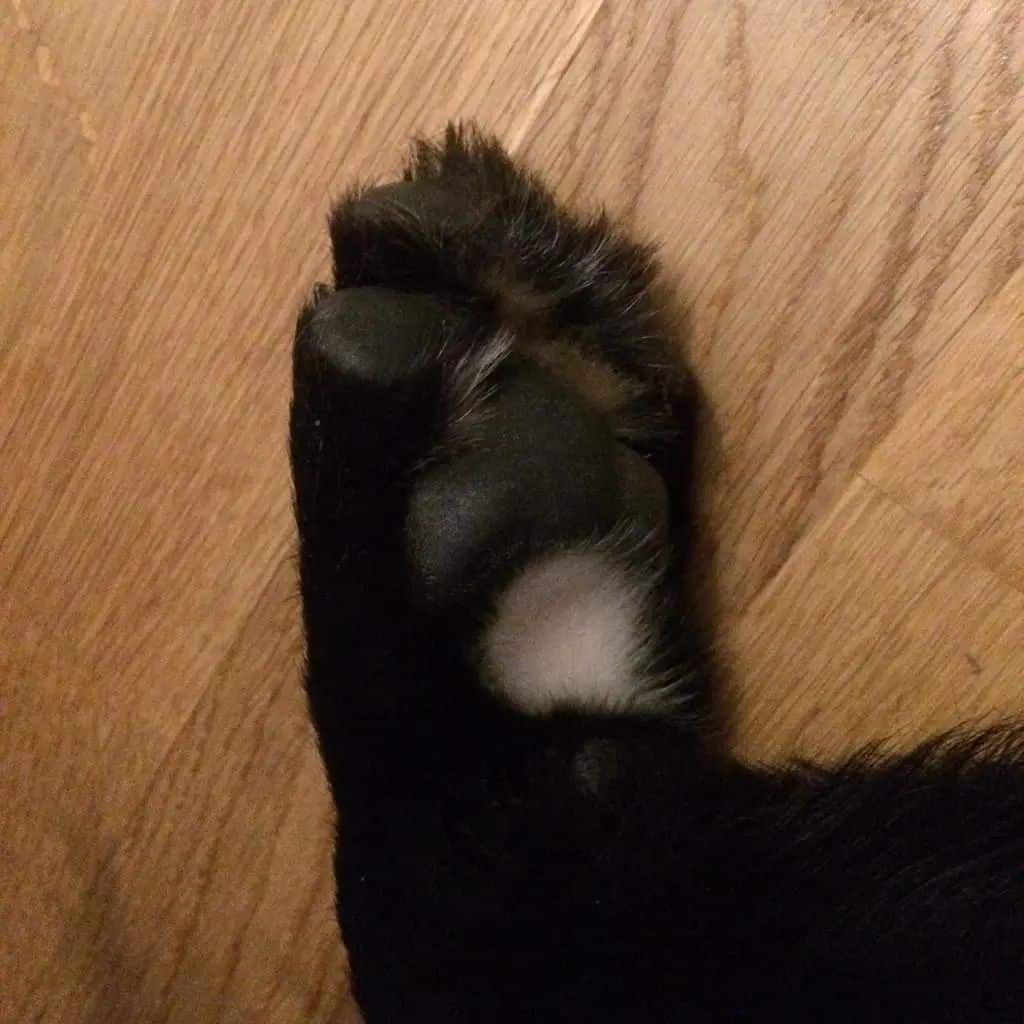
Photo from: @mambo.theblacklab
Bolo marks are very interesting inherited features found only in Labrador Retrievers!
These marks are little white spots found on a Labrador’s feet. They’re not the same as the white patches we talked about earlier. Bolo marks range anywhere from an inch to three or four inches.
Does my dog have bolo marks?
You can easily check if your Labrador has bolos. Tell your Lab to give you a high-five and check out his paws!
Bolo marks are located right behind the metacarpal paw pads on the foreleg, and metatarsal paw pads on the hindleg.
Some puppies can have bolo marks on the tips of their fingers, but this is more uncommon because they’re usually located behind the paw pad.
Note that if there are any similar marks located anywhere else but the feet, they are not considered bolo marks.
Newborn puppies might have inherited bolo marks that can be seen in the early days of life. As time goes by, they can fade away or be covered by longer, darker hairs.
These marks got their name from the Banchory Bolo Labrador Retriever, known as the first dual champion dog in England back in the ’20s.
His first litter had puppies born with these specific markings!
It’s remarkable how this specific genetic trait has been passed on to many Labrador Retriever puppies today.
Conclusion
Black, yellow, chocolate, silver, red, rainbow-colored… you’ll want them all!
How did that famous saying go again?
“The suit doesn’t make the man… ermm, the dog! The dog makes the suit!”
Different colors of a coat are a person’s preference. Some like black dogs, some like yellow. Some choose to find the most unique pup in the litter.
Although this shouldn’t be the case, many rare combinations may be higher in price since they’re very hard to achieve by selective breeding.
When deciding to get a dog, the whole Labrador Retriever breed should be taken into consideration.
Future paw parents will have to do lots of research before getting their new Lab pup. Take notes about this breed’s temperament, health issues, and nutritional and exercise needs.
By providing proper care, you’ll get the most beautiful, happiest doggo!
Read Next:
• 10 Trustworthy Labrador Breeders In Ontario (2022)
• Charcoal Lab: Unique Labrador Retriever Color
• 8 Labrador Breeders In Colorado For A Lifetime Of Friendship
